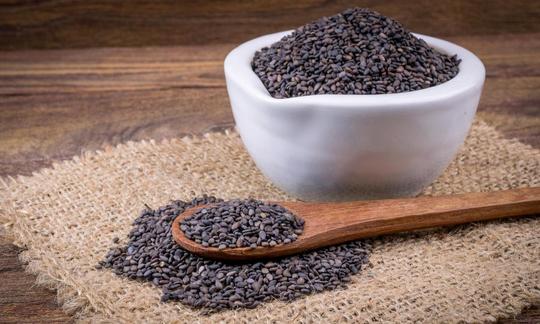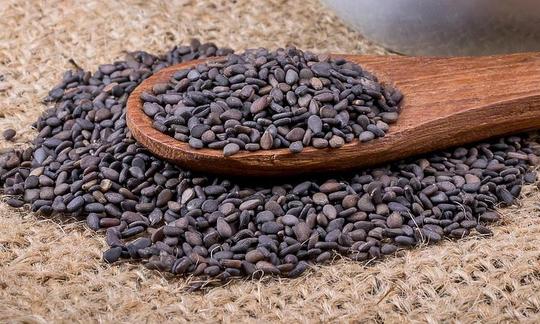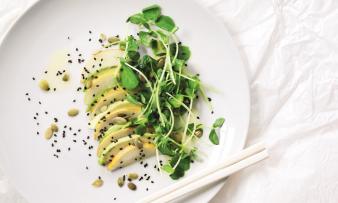Table of contents
Black sesame ( Sesamum indicum nigrum) tastes more aromatic when raw than light sesame seeds. Prefer organic sesame seeds.
Use in the kitchen
In addition to being processed into sesame oil, black, brown, yellow or white sesame seeds are also used for cooking, seasoning soups and salads and for refining baked goods (Turkish flatbread, bagels or crispbread) and desserts. As a gluten-free pseudo-cereal, sesame gives smoothies, crackers, muesli bars or muesli ( Erb-Müesli) an energy-giving and aromatic note. Black sesame seeds taste a little more bitter and intense than light sesame seeds. In Europe, light sesame seeds are much better known than their dark relatives.
Although peeled seeds are better for certain delicate desserts, unpeeled sesame seeds (such as black sesame) can also be used for many dishes. If you break open the shell beforehand with a mortar or grind the raw seeds, for example with a mill, then they are easier to digest. Their own flavor also comes out better this way.
The whole, unroasted sesame seeds can also be processed into a paste. In Arabic cuisine, this sesame butter is used under the name tahini (tahina): prepared with black sesame seeds, tahini is something very special. In spice mixtures, unroasted sesame seeds are known as 'zahtar' in Jordan and 'dukka' in Egypt. 1
In many countries, sesame seeds are briefly roasted in a pan to intensify their nutty, aromatic taste. In the Far East, for example, sesame seeds are used as an ingredient in spice mixtures or sprinkled (sometimes mixed with salt as gomasio or gomashio) over sauces, salads or starters just before serving. The taste is very similar to roasted sesame oil (Chinese sesame oil).
It is best to use raw, unpeeled black sesame seeds, so that the valuable nutrients and building blocks are preserved. Sesame seeds can also be eaten germinated, which increases the amount of nutrients and makes them easier for the body to absorb. Soaking the seeds for 24 to 48 hours causes them to germinate a little. However, as soon as the germ becomes clearly visible, the mild taste changes to bitter.
Vegan recipe for black sesame cake
Ingredients (14 servings) : 300 g black sesame, 500 ml rice milk (other plant-based drinks are also possible), 100 g ground buckwheat, 250 g grated almonds, 1 packet of baking powder, 80 g agave syrup (agave nectar), 120 ml neutral-tasting vegetable oil (e.g. rapeseed oil).
Ingredients for the sesame cream: 50 g agave syrup and 100 g tahini.
Preparation: Soak the sesame seeds with rice milk for about 1 hour. Meanwhile, mix the buckwheat flour, ground almonds and baking powder well in a bowl. Puree the sesame-rice mixture well with a hand blender or mixer. Mix 2⁄3 of the mixture well with agave syrup and oil. Pour the dough into a greased dish and bake in a preheated oven for about 40 minutes at 160 °C.
In the meantime, mix the remaining sesame mixture with agave syrup and tahini. After cooling, spread the sesame cream on the cake. If you let the cake "set" for about an hour, it tastes even better. 2
Vegan recipes with black sesame (raw) can be found under the note: " Recipes that have the most of this ingredient ".
| Not only vegans or vegetarians should read this: Vegans often eat unhealthily. Avoidable nutritional errors. |
Purchasing - Storage
Light sesame seeds can be found in almost all supermarket chains such as Coop, Migros, Denner, Volg, Spar, Aldi, Lidl, Rewe, Edeka, Hofer, Billa etc. Black sesame seeds, on the other hand, can only be found in selected supermarkets, organic supermarkets (e.g. Denn's Biomarkt, Alnatura), organic shops, health food stores, delicatessens or in some drugstores as well as in online shops. However, they are available there all year round. If possible, organically produced, fairly traded and unpeeled sesame seeds are preferred.
The availability of black sesame varies depending on the size of the store, catchment area, etc. Our recorded food prices for the DA-CH countries can be found above under the ingredient image - and by clicking you can see their development at various suppliers.
Found in the wild
In the tropical regions of Africa and Asia there are many wild species of Sesamum indicum. Sesamum radiatum is also called 'black sesame' or 'black benniseed' in English. This is a wild-growing sesame plant from West and Central Africa. In addition to the seeds, the shoots and young leaves are also eaten as a vegetable. 3
Storage tips
Sesame seeds can be stored for several months in a cool, dark place. If kept in an airtight container, they will last for about a year.
Ingredients - Nutritional value - Calories
Sesame has a very high energy content of 573 kcal/100g, which is primarily due to the fat content (50 g/100g). The fat contains a large proportion (21 g/100g) of the inflammation-promoting linoleic acid (omega-6 fatty acid). The ratio of omega-6 to omega-3 is not particularly good at 57:1. However, it is still better than sesame oil (138:1). Linseed has less linoleic acid at 5.9 g/100g and, because it has more alpha-linolenic acid (omega-3 fatty acid) (23 g/100g), it also has a significantly better ratio of 1:4. 4
Sesame contains plenty of protein (18 g/100g) and an amino acid composition that is rather unusual for oilseeds. 5 While amino acids such as lysine or leucine are less present, sesame is rich in sulfur-containing amino acids, e.g. methionine (0.59 g/100g). Tryptophan is even more present (0.39 g) (156% of the daily requirement), similar to black mustard seeds. Dried porcini mushrooms have about four times as much (1.5 g/100g). 4
Manganese is present in sesame seeds at around 2.5 mg/100g. Linseed and black cumin also contain the same amount. Wheat germ (13 mg/100g) and teff (9.2 mg/100g) have particularly high levels of this essential trace element. Manganese is very important for healthy cartilage tissue. A balanced diet that also contains nuts and seeds will cover your needs very well. 4
You often read that sesame contains a lot of selenium. However, the content can vary greatly depending on the region where it is grown. According to the USDA, the selenium content of black sesame is on average 34 µg/100g (63% of the daily requirement), similar to that of pearl barley (38 µg). Brazil nuts have a much higher level of the semi-metal at around 1917 µg/100g.
The recommended daily amount of selenium is not entirely uniform. 4 Depending on the source, it ranges from 40 µg to 70 µg per day for adults. 6,7 The EFSA ( European Food Safety Authority) recommends 15 µg/day for children; 70 µg/day for adolescents aged 15 and over and adults. Pregnant women should consume a little more, 85 µg/day. 7 Selenium is essential and, if the supply is optimal, can even have a preventive effect against cancer. 23 However, an excess supply can also be reached quickly and can cause symptoms of poisoning.
Sesame seeds contain valuable fat-accompanying substances (lignans) such as heat-stable tocopherols and vitamin E as well as sesamin and sesamolin. These antioxidants largely prevent the oxidation of sesame (oil), although the unsaturated fatty acids they contain, oleic acid (monounsaturated omega-9 fatty acid, 18:1, i.e. 18 carbon atoms) and linoleic acid (double-unsaturated omega-6 fatty acid, 18:2), are very sensitive to atmospheric oxygen. Vitamin E, which occurs primarily as gamma-tocopherol, significantly improves the oxidation stability of sesame (oil). 26,27,28
The complete ingredients of black sesame (raw), the coverage of the daily requirement and comparison values with other ingredients can be found in our nutrient tables. In the article Nutrients explained you will get a detailed insight into the topic.
Health effects
What is black sesame good for? Black sesame can help to significantly lower blood pressure when consumed regularly. In a study that reached this conclusion, patients with high blood pressure consumed small amounts of black sesame flour every day for four weeks. 9
The highfiber content of whole, unprocessed sesame seeds can promote digestion when consumed regularly.
Sesame seeds are gluten-free and are therefore recommended as a dietary food for people with celiac disease (a disease of the gastrointestinal tract caused by gluten intolerance) or gluten sensitivity. Depending on the severity of the disease, look for products with the appropriate labeling, e.g. with the gluten-free symbol (usually a crossed-out ear of corn). Contamination by products containing gluten can occur during harvesting, cleaning, peeling, etc.
Secondary plant substances
Many of the health effects of black sesame can be attributed to the secondary plant substances it contains. Our article on secondary plant substances provides an overview of the classification of substance groups, their occurrence in foods and possible effects on humans. Black sesame contains the following secondary plant substances:
- Isoprenoids: Terpenes: Phytosterols, Steroids (campesterol, stigmasterol,beta-sitosterol) 15.25
- Polyphenols: Phenolic acids: Hydroxybenzoic acids (gallic acid); Lignans (sesamol, sesamin, sesamolin, sesaminol), tannins 8,10,15,25
- Other organic compounds: Quinones (anthraquinones) 15
- Protease inhibitors: phytic acid 15
However, it should be noted that the composition of the secondary plant substances in black sesame can vary depending on the variety, time of harvest and growing conditions. Therefore, quantities are only of limited use and should only be understood roughly.
To date, 180 different phytochemicals have been found in sesame seeds. Sesamin and sesamol are said to have anti-inflammatory, antioxidant, anti-cancer, anti-melanogenic, hearing-protective, cholesterol-lowering and anti-aging effects. They are also said to protect the heart, liver and kidneys. 15 The phytoestrogens contained in sesame can lower cholesterol and blood pressure and increase antioxidant capacity. 8 They are also said to have a preventive effect against breast cancer. 10
The oil found in sesame contains a lot of lecithin, which is effective against fatty liver disease and dermatitis. It has also been shown to have a selective effect against skin and colon cancer. 25
Dangers - Intolerances - Side effects
Sesame is a strong allergen that must be declared. In Europe, sesame allergy is rare, but in Australia it is one of the most common food allergies. Cross-reactions can also occur, e.g. if you are allergic to peanuts or walnuts, you will often react to sesame as well. In sensitive people, the symptoms of a sesame allergy can be very severe and even trigger an allergic shock. In some cases, a contact allergy is also possible. 24
Sesame contains anti-nutritional factors such as oxalic acid, phytic acid and tannins. These anti-nutritional factors can inhibit the absorption of other nutrients (minerals). 15 Read more about this in the article Phytic acid or phytate and soaking or sprouting.
Folk medicine - natural healing
In traditional Chinese medicine ( TCM), black sesame is highly valued. Whole seeds as well as cold-pressed sesame oil from black seeds are used.
Ecological footprint - animal welfare
Sesame produced in Mexico has a CO 2 footprint of 0.63 kg CO 2 eq/kg (from production to the farm gate - "cradle-to-gate"). Sesame seeds from China have a CO 2 footprint of 0.97 kg CO 2 eq/kg. Both values refer to a specific product. 14 Depending on the cultivation method, vegetables have a CO 2 footprint of approx. 0.1-0.5 kg CO 2 eq/kg. 19 The average CO 2 footprint of plant-based foods is approx. 0.66 kg CO 2 eq/kg, which only accounts for 10.7% of the CO 2 emissions of animal products (6.15 kg CO 2 eq/kg). 18 To keep the CO 2 footprint small, it is best to eliminate animal products from the menu. 20
The Danish climate database Concito comes to 5.14 kg CO 2 eq/kg for hulled sesame. In addition to production, indirect land use also has a strong influence on this value. 16
The water footprint of sesame seeds totals 9371 l/kg. Nuts have a comparable average water footprint. The largest part of this, both for sesame and nuts, is the so-called 'green water'. 17 Sesame needs a lot of water 21 and is even comparable to animal products. 22 However, data on the water consumption of sesame is scarce. Sesame is actually a cultivated plant that can survive well with little water; however, more water enables a higher yield.
For detailed explanations of various sustainability indicators (such as ecological footprint, CO2 footprint, water footprint), see our article: What does the ecological footprint mean?
Animal welfare - species protection
Sesame is generally seen as a self-pollinating plant, but its structure and attractiveness also show that it tries to attract cross-pollination. As part of a research project at the University of Rostock, a biologist in West Africa was able to show that wild and honey bees are important for a high sesame yield. Through pollination, farmers can increase their yields by up to 60%. 13 It can be assumed that sesame has good nectar and pollen values and is a good bee pasture and food source for insects.
Worldwide occurrence - cultivation
It cannot be said with certainty whether black sesame is really the origin or the original form of sesame ( Sesamum indicum). In any case, sesame is the oilseed that has been known for the longest time: in 2350 BC it was cultivated in what was then Mesopotamia (Mesopotamia). However, the area of origin is believed to be in southeast Africa. 11 Today, many wild sesame species can be found in these two regions.
The main growing countries for black and darker sesame seeds are China and Southeast Asia. 12
Due to their similar shape and color, the seeds of black sesame ( Sesamum indicum nigrum) can be confused with black cumin ( Nigella sativa). However, the taste is very different.
Cultivation - Harvest
Sesame is a very undemanding plant and is very popular in small-scale, extensive (mainly organic) agriculture, e.g. in Africa. The annual, herbaceous plant requires hardly any fertilizer and gets by with very little water, as its long taproots reach deep into the earth. 3
Their height ranges from 10 cm to a maximum of 180 cm. The flower color can range from white to light to dark pink.
Special breeding has made it possible to harvest before full ripeness, so that the seed capsules only open after a drying phase through intensive shaking.
Further information
What is sesame? Sesamum indicum nigrum was previously considered a separate species or rather the original species of sesame. Today it is considered a color variety of sesame ( Sesamum indicum) . Sesame belongs to the sesame family (Pedaliaceae), which is mainly found in the tropics, subtropics or dry locations.
Alternative names
Sesame is also known in some places as Vanglo, but this name is extremely rare. In English, black sesame is simply called black sesame. Sesame seeds are also called sesame, gingelly, semsem or benne. In Hindi, black sesame is called Kali til. 1
Other uses
In addition to its use as a food, sesame oil is particularly valuable for the cosmetics industry - for various cosmetics, body ointments and soaps. Sesame oil is also used for oral hygiene as a so-called 'oil pulling treatment'. The oil is used as a massage oil or for oil pouring in traditional Indian massages.
Bibliography - 28 Sources
| 1. | Gernot Katzers Gewürzseiten. Sesam (Sesamum indicum L.). |
| 2. | Göb S. Meine vegane Küche. Rezept: Schwarzer Sesamkuchen. AT Verlag. 2013. |
| 3. | Rehm S, Espig G. Die Kulturpflanzen der Tropen und Subtropen. Anbau, wirtschaftliche Bedeutung, Verwertung. Eugen Ulmer: Stuttgart. 1976. |
| 4. | USDA United States Department of Agriculture. |
| 5. | Kim JS. Einfluss der Temperatur beim Rösten von Sesam auf Aroma und antioxidative Eigenschaften des Öls. Dissertation, Technische Universität Berlin. 2001. |
| 6. | De Groot H, Farhadi J. Ernährungswissenschaft. 6. Auflage. Verlag Europa-Lehrmittel: Haan-Gruiten. 2015. |
| 7. | European Food Safety Autorithy EFSA. Scientific opinion on dietary reference values for selenium. EFSA Journal. 2014;12(10):3846. |
| 8. | Alipoor B, Haghighian MK, Sadat BE, Asghari M. Effect of sesame seed on lipid profile and redox status in hyperlipidemic patients. International Journal of Food Sciences and Nutrition. September 2012;63(6):674–8. |
| 9. | Wichitsranoi J, Weerapreeyakul N et al. Antihypertensive and antioxidant effects of dietary black sesame meal in pre-hypertensive humans. Nutrition Journal. 2011;10(8):82. |
| 10. | Watzl B, Kulling S. Phytoöstrogene. Ernährungsumschau. Heft 6. 2003. |
| 11. | Brücher H. Tropische Nutzpflanzen. Ursprung, Evolution und Domestikation. Springer: Berlin, Heidelberg, New York. 1977. |
| 12. | Hansen R. Sesame (Sesamum indicum) seeds and oil meal. Iowa State University. USA. 2011. |
| 13. | Stein K, Coulibaly D et al. Bee pollination increases yield quantity and quality of cash crops in Burkina Faso, West Africa. Scientific Reports. 2017;7:17691. |
| 14. | Carboncloud. Schweden. Sesame. 2024. |
| 15. | Wei P, Zhao F et al. Sesame (Sesamum indicum L.): a comprehensive review of nutritional value, phytochemical composition, health benefits, development of food, and industrial applications. Nutrients. 2022;14(19):4079. |
| 16. | CONCITO. The big climate database. Version 1.1. Sesame seeds, decorticated. 2024. |
| 17. | Mekonnen MM, Hoekstra AY. The green, blue and grey water footprint of crops and derived crop products. Hydrol Earth Syst Sci. 2011;15(5):1577–1600. |
| 18. | Feng S, Lakshmanan P et al. A comprehensive continental-scale analysis of carbon footprint of food production: Comparing continents around the world. Journal of Cleaner Production. 2023;426:138939. |
| 19. | Pereira B de J, Cecílio Filho AB, La Scala N. Greenhouse gas emissions and carbon footprint of cucumber, tomato and lettuce production using two cropping systems. Journal of Cleaner Production. 2021;282:124517. |
| 20. | Barthelmie RJ. Impact of dietary meat and animal products on GHG footprints: the UK and the US. Climate. 2022;10(3):43. |
| 21. | Mehla MK, Kothari M et al. Assessment of water footprint for a few major crops in Banas River Basin of Rajasthan. JANS. 2022;14(4):1264–1271. |
| 22. | Mekonnen MM, Hoekstra AY. A global assessment of the water footprint of farm animal products. Ecosystems. 2012;15(3):401–415. |
| 23. | Lee EH, Myung SK et al. Effects of selenium supplements on cancer prevention: meta-analysis of randomized controlled trials. Nutrition and Cancer. 2011;63(8):1185–1195. |
| 24. | Mühlenbein S, Pfützner W. Allergien auf Sesam: klinische Bedeutung, Diagnostik und Therapie. Allergo J. Mai 2018;27(3):46–57. |
| 25. | Oboulbiga EB, Douamba Z, Compaoré-Sérémé D, Semporé JN, Dabo R, Semde Z et al. Physicochemical, potential nutritional, antioxidant and health properties of sesame seed oil: a review. Front Nutr. 2023;10:1127926. |
| 26. | Moazzami AA, Kamal‐Eldin A. Sesame seed is a rich source of dietary lignans. J Americ Oil Chem Soc. 2006;83(8):719-723. |
| 27. | Chau CF, Ciou JY, Wu CL. Commercialized sesame oil analysis: quality characterization and oxidative stability of blended sesame oil. ACS Food Sci Technol. 2021;1(7):1222-1227. |
| 28. | Rangkadilok N, Pholphana N, Mahidol C, et al. Variation of sesamin, sesamolin and tocopherols in sesame (Sesamum indicum L.) seeds and oil products in Thailand. Food Chemistry. 2010;122(3):724-730. |













Comments